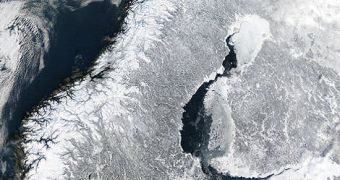Geologists at the University of Maryland may have just made one of the most important discoveries to explain the ancient history of our planet, namely what it was that triggered one of the earliest Ice Ages in history. A new scientific research seems to point at the fact that the appearance of oxygen, synthesized by emerging vegetation, was the main factor that caused global cooling, and, eventually, the first glaciation. As more oxygen was created, greenhouse gases such as carbon dioxide were sucked up from the atmosphere, and the entire Earth gradually cooled, until the ices took over.
According to UM Professor of Geology Alan J. Kaufman, who was involved with the recent studies, the era when oxygen first started showing up is known as the Great Oxygenation Event. His attention to this line of study was drawn by the fact that this epoch almost perfectly coincided with the first widespread glaciation in our planet's history. He then set out to uncover pieces of evidence to prove his hypothesis, and was joined in this endeavor by colleagues from Germany, South Africa, Canada, and the US.
“We can now put our hands on the rock library that preserves evidence of irreversible atmospheric change. This singular event had a profound effect on the climate, and also on life,” Kaufman said. Analyzing rocks from the Transvaal Supergroup region of South Africa, about 2.3 billion years old, the team determined that a sudden increase in atmospheric oxygen levels perfectly coincided with the physical evidence of glacial debris, as well as with the geochemical evidence of a shifting in the global carbon dioxide patterns. The experts used sulfur isotopes to determine the oxygen content of the rocks.
“The sulfur isotope change we recorded coincided with the first known anomaly in the carbon cycle. This may have resulted from the diversification of photosynthetic life that produced the oxygen that changed the atmosphere,” the UM geologist added. He went on to say that, at first, plants oxygenated the ocean waters and produced iron oxides, which then fell to the ocean floor. It was only later that the atmosphere got an oxygen boost as well, geological evidences show.
When that happened, greenhouse gases were absorbed and stored in the increasing vegetation. “With less warming potential, surface temperatures may have plummeted, resulting in globe-encompassing glaciers and sea ice,” Kaufman explained. “New oxygen in the atmosphere would also have stimulated weathering processes, delivering more nutrients to the seas, and may have also pushed biological evolution towards eukaryotes, which require free oxygen for important biosynthetic pathways.”

 14 DAY TRIAL //
14 DAY TRIAL //